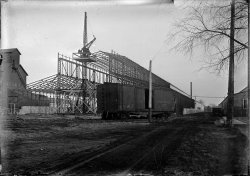
MAY CONTAIN NUTS

Search Shorpy
SHORPY ART

Framed or unframed, desk size to sofa size, printed by us in Arizona and Alabama since 2007. Explore now.
Join and Share
Ad-Free Shorpy
Shorpy is funded by you. Patreon contributors get an ad-free experience.
Learn more.

Recent comments
- Details, Details
- What's that building to the left of the tower?
- Coal Barges
- Bromo-Seltzer
- Inner harbor
- The Basin
- What a headache!
- Giant stepladder?
- Baldwin 62303
- Baldwin VO-1000
- Cold
- No expense spared
- Tough Guys
- Lost in Toyland
- And without gloves
- If I were a blindfolded time traveler
- Smoke Consumer Also Cooks
- Oh that stove!
- Possibly still there?
- What?!?
- $100 Reward
- Freeze Frame
- Texas Flyer wanted
- Just a Year Too Soon
- WWII -- Replacing men with women at the railroad crossing.
- Yes, Icing
- You kids drive me nuts!
- NOT An Easy Job
- I wonder
- Just add window boxes
Member Photos
The Shorpy
Print Emporium
Print Emporium
Search Shorpy
Search results -- 30 results per page
- Inside Information: 1954
- ... six people Yep, it's 1954.
Time travel So many railroads, so few airlines.
Graveyard Listings There are at least 25 ... Posted by Dave - 10/30/2014 - 11:30am -
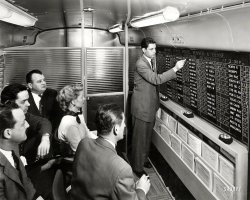
- Ghosts of State Street: 1908
- ... place for the old photo.
If this had been the "Indiana Railroads Bull Session" forum, this photo would have been prime for a ... Posted by Dave - 04/12/2013 - 12:27pm -
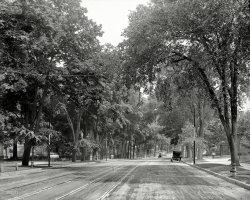
- River Cruise: 1906
- ... causing steamboat companies to run extra boats, and railroads to add cars and extra trains to handle the crowds. These yearly ... Posted by Dave - 07/20/2012 - 7:20pm -
![River Cruise: 1906 Circa 1906. "Steamer New York on the Hudson. Boat landing at Kingston Point." 8x10 inch glass negative, Detroit Publishing Company. View full size.
Rhyme, no; reason, yes.The sparse crowds on shore in their jackets, and the clear decks of the New York indicate this is off season.
All summer long the crush of humanity would escape to the Catskills, causing steamboat companies to run extra boats, and railroads to add cars and extra trains to handle the crowds. These yearly summer-long events wouldn't begin to ease off until about the time of the Great War.
You need to see some photos of Kingston Landing or Catskill from the same era in summertime. Those benches were very much needed.
Steamboat New York 1887This steamboat was one of more than 3,000 painted by the famous steamboat (and sailing ship) artist James Bard in 1887. Born in 1815, he died in 1897.
Albany?I'm curious as to why the roof over the platform on the right has "Albany" painted on it.
[The Day Line operated the steamers New York and Albany between New York and Albany.]
New York and the PointThe Hudson River Day Line boat "New York", while laid up for repairs, burned to the hull in Newburgh, NY in 1908. New York's machinery was recycled for use in her replacement, the "Robert Fulton".
Hiding on the other side of the covered platform is a train of the Ulster and Delaware RR. The train will make a broad turn to the right in the distance and run across the long fill to Rondout and on to Kingston and the Catskill Mountains.
We are much more civilized today...hop in the family Studebaker and take off.
DisarrayThere really is no rhyme nor reason to those benches, is there?
NY explainedHank adds this to the mix:
Another great picture.
From Don Ringwalds book on the Day Line:
SS New York: Reg #130373; Built 1887, Harlan & Hollingsworth, Wilmington DE. 301 ft long, 40.2 beam, 11' draft; 1552.52 grors tons cost abot $242,000
Lengthened 1897-98, 335' x 40.4' x 11.2', 1974 gross, 1261 net tons. Fletcher beam engine; 1 cyl 75" bore, 12 ft stroke. 3850 hp
Caught fire during layup at Marvel yard, Newburgh, Oct 20, 1908, burned completely.
Day Line needed a new boat for the 1909 season, with the Hudson-Fulton celebration. They had been considering another big boat like the Hendrik Hudson, but cost was high. Now they had an urgent need for some kind of a new boat. It was found that engine and boilers from SS N.Y. could be reusedd, thus saving considerable time. These were built into the SS Robert Fulton:
SS Robert Fulton: Reg #203424, Built 1909. New York Ship Building Co, Camden NJ. 337' x 42' x 11.5' 2168, 1344 net tons. Same engine cost about $500,000
Operated 1909-1954. Sold 1956.
I have ridden on the Fulton at least twice.
________________________________________
(The Gallery, Boats & Bridges, DPC)](https://www.shorpy.com/files/images/SHORPY_4a18014a.thumbnail.jpg)
- Old Coal King: 1940
- ... LC&N leased its railroad properties to other railroads and concentrated on anthracite mining. In 1940 though, Lansford ... Posted by Dave - 04/10/2020 - 4:49pm -
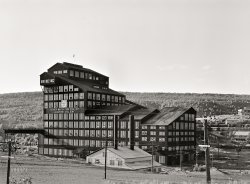
- A Dark Chapter, in Color
- ... Hall, and it sat right up against the main line of the railroads. Years of steam and southern humidity would have made the ... Posted by Fredric Falcon - 09/20/2011 - 1:22pm -
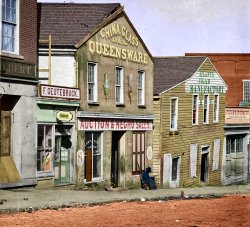
- City of Alpena: 1899
- ... Detroit and Saginaw in the years before completion of railroads and highways to the communities of booming Northeast Michigan.
... the lumbering industry had moved to the West Coast and railroads connected most of the towns in the region. She operated afterward on ... Posted by Dave - 08/12/2016 - 3:41pm -
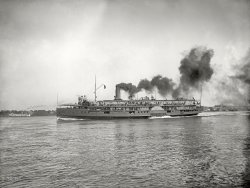
- Crate and Barrel: 1906
- ... quite a transportation empire primarily based on Southern railroads, but of which the steamship company was a prime component. His heirs ... Posted by Dave - 08/08/2012 - 2:01pm -
![Crate and Barrel: 1906 Circa 1906. "Dock conveyors, New Orleans." On the waterfront along the Mississippi. 8x10 inch glass negative, Detroit Publishing Co. View full size.
I'm just dying to knowWhat's in those crates and barrels! Any guesses?
Machine Age at the docksWas impressed to note the labor saving conveyor belt moving those hand trucks efficiently along. Comparing the motion blur of people versus belt, that thing offered very little opportunity to rest one's back.
Pretty nifty hoist assembly up above as well. Wonder how that worked? Gotta love those gears.
Those barrels do look provocative, don't they?
DetailsI noticed the conveyor also, I wonder what powers it? It appears that they are offloading the ship and the conveyor must be capable of running either direction.
The man walking parallel to the conveyor (away from ship) has something stuck in his belt. It's not a radio and too large to be the butt of a pistol?
[It's the handle of a longshoreman's hook. - Dave]
Re: I'm just dying to knowIf this were an episode of The Simpsons, all those crates and barrels would be filled to the brim with hot pants.
Fancy ApronThe hoist mentioned below, with all the pulleys, is not for handling cargo. The boom on the ship, with its base on the deck-house and its attendant lines rigged to the mast is doing that. Ships of this era were fully capable of loading and unloading themselves in even the most undeveloped port.
The hoist raises and lowers the outboard ends of two aprons fixed to the pier. Thus the aprons (ramps) could be adjusted to any deck height or tidal condition.
Only the apron with the moving belt is in use, and the power seems to be a mystery. A giant hamster-wheel out of view, perhaps. The belt does seem to be valuable enough to justify a long canvas cover to protect it from the weather when not in use.
The vessel shownhere is the New York, built of iron in 1875 at Wilmington, Delaware, by Harlan & Hollingsworth for Charles Morgan's Morgan Steamship Company. She measured 283 feet in length, powered by the typical triple-expansion steam engine of the day. She was broken up in 1923. Charles Morgan instituted the first steamship line on the American East Coast in 1834. By the time of Morgan's death in 1877, he had amassed quite a transportation empire primarily based on Southern railroads, but of which the steamship company was a prime component. His heirs sold their holdings to C. P. Huntington, who merged them into the Southern Pacific in 1888, but the steamship operation remained known as the Morgan Line until wound up in 1941.
Since Morgan operated a service between Havana and New Orleans at the time this photograph was taken, I suspect the contents of the barrels are either molasses or its potent by-product, rum.
Nifty HoistThat's called a gantry, I'm sure it is used to lift the end of the bridge the conveyor is on. This allows for the transition of heights of decks of different ships and tidal changes, too. It hinges on the dock end.
Not a walkie-talkieSign of the times. I did a double take on that hook handle, it looks so much like a walkie-talkie!
*Click* "Hey Joe, tell the boys to stay off the conveyor if they wanna keep their shoes polished. There's a nasty surprise at the far end!"
And let's hope there's nothing in those barrels that would offend Temperance.
(The Gallery, Boats & Bridges, DPC, New Orleans)](https://www.shorpy.com/files/images/4a17914a.thumbnail.jpg)
- S.S. Utica: 1910
- ... citing the 1912 Panama Canal Act, ruled that American railroads could not also engage in marine transportation, and the NYC (as well ... Posted by Dave - 08/14/2012 - 8:50pm -
![S.S. Utica: 1910 Circa 1910. "Freighter S.S. Utica, New York Central and Hudson River Railroad Line." 8x10 inch glass negative, Detroit Publishing Company. View full size.
1904-1949Constructed by the Detroit Ship Building Co., this 325-foot package freighter was launched April 28, 1904, at Wyandotte for the Western Transit Company, the marine operation of the New York Central on the Great Lakes.
In 1915 the Interstate Commerce Commission, citing the 1912 Panama Canal Act, ruled that American railroads could not also engage in marine transportation, and the NYC (as well as Erie, Pennsylvania, and Lehigh Valley) sold their steamship operations on the Great Lakes. Many of the vessels were consolidated under a new firm, Great Lakes Transit Corporation, for which the Utica ran from 1916 until 1945. That year, GLTC sold her to Chilean interests who renamed her Quintay. She was towed down the Chicago River, the Chicago Sanitary and Ship Canal, the Illinois River, and eventually the Mississippi to New Orleans.
The Quintay stranded and became a total loss on Penguin Island in the Messier Channel, Chile, on April 28, 1949, on a voyage from Callao to Punta Arenas while carrying general cargo and drums of oil.
Steamship Utica
Beeson's Marine Directory of the Northwestern Lakes, 1908
Steamship Utica, built in 1904 for the Western Transit Co. of Buffalo, N.Y. Gross tonnage: 3533, length: 325 ft., beam: 44 ft.
HmmmmI wonder what the three planks on the side of the hull are.
[Docking fenders. - Dave]
Rounding the Eastern Continent?I was not aware a vessel of this size could move South out of Lake Michigan and down thru to New Orleans in the canal/river system.
[As noted below, the Utica was a Great Lakes freighter. - Dave]
(The Gallery, Boats & Bridges, DPC)](https://www.shorpy.com/files/images/4a16007a.thumbnail.jpg)
- Home, James: 1910
- ... of War. In his spare time, he made a fortune in lumber and railroads.
No longer there Lost to development in the 1960s.
... Posted by Dave - 10/24/2020 - 2:12pm -
![Home, James: 1910 Grosse Pointe, Michigan, circa 1910. "F.M. Alger residence." The home of banker-industrialist Frederick Moulton Alger. 8x10 inch glass negative, Detroit Publishing Company. View full size.
A story of three Freds (and a Frances)To the right of Fred, and between the two pooches, are Miss Francis Alger and Master Fred Alger Jr.. Fred Jr., like his father, would enter politics, ultimately serving as an Ambassador to Belgium during the Eisenhower Administration. His two sons - Fred Alger and David Dewey Alger - were the first and second CEOs of Fred Alger Management, a fund investment firm with principal offices on the 93rd floor of the World Trade Center. The September 11 attacks killed David and most of the firm's analysts, but Fred (who had moved to Switzerland) returned to rebuild the company.
https://www.alger.com/AlgerDocuments/Money_ReincarnationofFredAlger.pdf
The oldest Fred served in the Army in the Spanish-American War and World War I. In World War II, Frances served in the Red Cross and Fred Jr. served in the Navy. His son Fred served in the Marines.
Before the Three FredsThe father of Fred the First was Russell Alexander Alger (1836–1907). Orphaned at 13, he worked on a farm to support his younger siblings. From those humble origins, he rose to become a Brevet Major General, Governor of Michigan, U.S. Senator, and Secretary of War. In his spare time, he made a fortune in lumber and railroads.
No longer thereLost to development in the 1960s.
https://www.higbiemaxon.com/blog/historical-architecture-of-grosse-point...
Fred's ChauffeurAs the title suggests, I don't think that's the elder Fred at the left of the photo. The gentleman is wearing the proper attire of a professional driver, and perhaps he's getting ready to take the car out of the garage for a trip (but first taking a few moments to play with the dogs/kids and pose for the photographer).
Are these really the Alger children?Frances would have been about six (born 1904) while Frederick (born 1907) would have been about three. The children in the photo are almost exactly opposites of what I expected.
[We're not sure who they are or when the photo was taken. But probably 1910 or earlier based on the license plates. - Dave]
(The Gallery, Detroit Photos, Dogs, DPC, Kids)](https://www.shorpy.com/files/images/SHORPY-4a22543a.thumbnail.jpg)
- Bedded Wheat: 1906
- ... be packed more efficiently on the barges.
Eventually railroads replaced the canal and the milling centers moved farther west.
... Posted by Dave - 08/20/2012 - 11:06am -
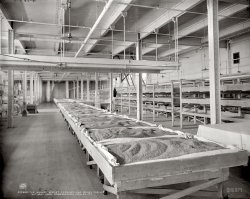
- Double Truck: 1941
- ... of 385 rigs, but by 1964 this was reduced to 50 as the railroads became a more efficient means to transport new vehicles. The firm ... Posted by Dave - 11/12/2017 - 2:07pm -
![Double Truck: 1941 October 1941. "Car transport filling up with gas at Little Falls, New York." Medium format negative by John Collier. View full size.
What make ?Is this a GMC cab over?
[Dodge. -tterrace]
There's one hidingI've never seen one like this either but I found a pic of a similar setup with open sides.
Chevy hidden insideToo much Dodge on the outside for it to handle.
The Sticker on the TruckI remember seeing trucks with that sticker having an "M" inside the shape of the US. Does anyone know what that signifies?
"M" Is For MarkelThe sticker on the truck that "Vonderbees" asked about is from Markel Service, Inc. Markel insured buses and trucks starting in 1930, and it was also involved in promoting safety and standards for drivers. The firm also helped to pass the National Motor Carrier Act of 1935. The firm exists today as Markel Corporation, and it is a Fortune 500 company.
As a part of their program to promote safety, drivers were given safety awards for each year that they did not have an accident. A variety of these awards and award certificates is shown below. The pin with number "1" in the red diamond is believed to be an early award as few of these are known to exist. Awards in the style of the 4-year pin shown seems to have followed, but these were likely awarded for only a short period of time as these are also very hard to find. Pins in the style of the 15-year award shown were issued into the 1950s, and the 20-year award was the last style issued.
The other side of the Dodge truck is seen in the photo below. The truck is from 1940, and this was the first year that the Dodge cab-over truck body was entirely designed, engineered, and built in-house. The previous three years the body was manufactured by Montpelier Company of Montpelier, Ohio. The 1940 models are easily identified by the lack of cowl lights which were on the 1941 and 1942 models. In this initial year of production 1 1/2 ton and 2 ton models were available. The cab could seat three, and it was up high enough that the floor of the cab was flat. The directional (turn) signal lights are mounted on the fender tops, and a Dodge ram hood ornament is visible.
Eastern Auto Forwarding of Buffalo, New York had orange trucks with green lettering. Their motto was "Dependable As The Rising Sun." They once had a fleet of 385 rigs, but by 1964 this was reduced to 50 as the railroads became a more efficient means to transport new vehicles. The firm was bought out by Buffalo based M&G Convoy in 1964.
Markel SpottingThere's at least one more truck with the Markel symbol on Shorpy. See it here.
(The Gallery, Cars, Trucks, Buses, Gas Stations, John Collier)](https://www.shorpy.com/files/images/SHORPY-8c33337a1.thumbnail.jpg)
- C&O Allegheny Locomotive: 1941
- ... right in time for the surge of war traffic on America's railroads.
RR shop Hey, thanks for a terrific shot of the designers ... Posted by Lost World - 12/13/2007 - 10:35pm -
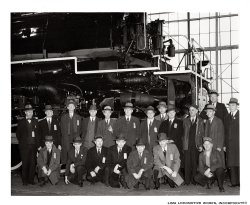
- Brand New Steamer: 1935
- ... loco, 4-8-4, was commonly called a Northern. But not on railroads running into Southern states such as Virginia, in this case. I've ... Posted by Lost World - 12/13/2007 - 10:34pm -
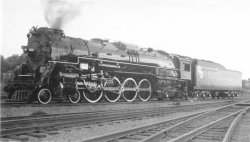
- Delta County: 1940
- ... the depression era and post WWII than the wagon trains and railroads.
Cars And they've done nothing but befoul our atmosphere and ... Posted by Dave - 06/27/2009 - 7:30am -
![Delta County: 1940 1940. Delta County, Colorado. "Hay stack and automobiles of peach pickers." View full size. 35mm Kodachrome transparency by Russell Lee for the FSA.
Will RogersWill Rogers once said something like "This is the only country in the world that ever went to the poorhouse in an automobile". The motor car probably had more to do with the westward migration of Americans during the depression era and post WWII than the wagon trains and railroads.
CarsAnd they've done nothing but befoul our atmosphere and ruin city planning ever since! They are pretty, though.
[They do one other thing: Get you where you want to go. - Dave]
CarsNot to mention enabling the greatest wealth and standard of living the world has ever seen.
Wonder how many horses would be required to replace those cars??? And the resources required by city planners to support them. Guess we could all go back to walking or bicycling across the country. But then you'd need to give up on fresh fruit and veggies.
The world would certainly get much bigger again for the masses.
(The Gallery, Agriculture, Cars, Trucks, Buses, Russell Lee)](https://www.shorpy.com/files/images/1a34202u.thumbnail.jpg)
- Morro Castle: 1901
- ... oceanic transportation, being almost entirely focused on railroads.
Cramps Shipyard is long gone This shipyard closed for the ... Posted by Dave - 03/19/2014 - 1:09pm -
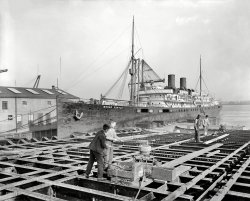
- War Effort: 1865
- ... ship). On land, it's draft animals pulling wagons, not railroads, although the latter were common in the time period and actually did ... Posted by Dave - 02/18/2014 - 8:22pm -
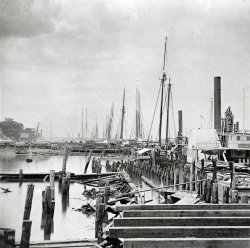
- Milwaukee of Buffalo: 1910
- ... I don't believe any survive in their original form after railroads and trucking took over their target business. Some had their side ... Posted by Dave - 11/09/2017 - 1:40pm -
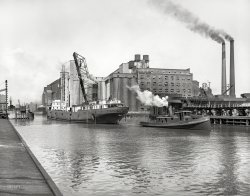
- Florida Pines: 1905
- ... in keeping them as passable as possible.
Southern railroads had to provide staffed agencies every five miles along their lines, ... Posted by Dave - 07/06/2015 - 5:26pm -
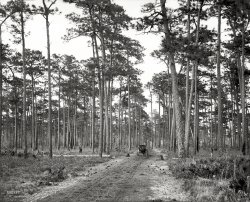
- Sweet Street: 1907
- ... being 5 feet between the rails, while freight and other railroads used the "standard" gauge of 4 feet 8.5 inches.
Two trolley ... Posted by Dave - 09/23/2016 - 12:03am -
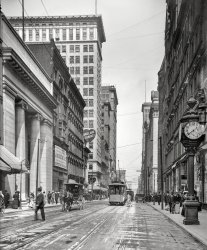
- Poughkeepsie Panorama: 1908
- ... Highway system, and the woes of the region's freight railroads led to a steady decline in the bridge's freight traffic (passenger ... Posted by Dave - 11/21/2013 - 11:12am -
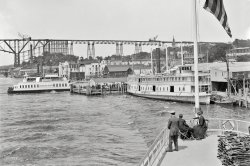
- At Your Call: 1948
- ... private express companies in WWI and later owned by the railroads, they primarily used the passenger train network of the day to move ... Posted by Dave - 02/09/2015 - 11:55pm -
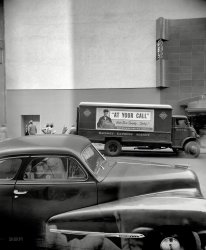
- The Trees' Knees: 1897
- ... H-S constituted a big step in safety and utility to the railroads, along with the other steel cars that began showing up around the ... Posted by Dave - 11/23/2017 - 4:22pm -
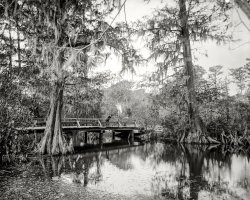
- Cane: 1938
- ... - at least in Hawaii - had their own narrow gauge railroads to carry the cut cane from the fields to the processing plants.
... Posted by Dave - 03/06/2019 - 11:34am -
![Cane: 1938 January 1938. "Train loaded with cane on a sugar plantation near Ponce, Puerto Rico." Nitrate negative by Edwin Rosskam. View full size.
Flag Cars?I think you mean flat cars. A lot of sugar plantations - at least in Hawaii - had their own narrow gauge railroads to carry the cut cane from the fields to the processing plants.
[The L.O.C. record of the photographer's caption for this image says "flag cars," two words. - Dave]
(The Gallery, Agriculture, Edwin Rosskam, Puerto Rico)](https://www.shorpy.com/files/images/8b30718u.thumbnail.jpg)
- Merchants of Manchester: 1910
- ... consulting engineer 936 Elm Room 13 {Steam and Electric Railroads, Water Works, Sewerage, Highways, Etc., Located and Construction ... Posted by Dave - 05/09/2020 - 4:01pm -
![Merchants of Manchester: 1910 Manchester, New Hampshire, circa 1910. "Elm Street." 8x10 inch dry plate glass negative, Detroit Publishing Company. View full size.
Elm Street TodayFrom Google Maps
https://www.google.com/maps/@42.9914005,-71.4630468,3a,88.6y,8.35h,86.9t/data=!3m6!1e1!3m4!1sOuCcXVEUf8SW67_YRzR3kA!2e0!7i16384!8i8192
The corner business on Spring and Elm is now a Ben and Jerry's. The building is the same. It has lost a bit of its charm, though.
[This might be a good time to learn how to embed a Google Street View! - Dave]
Then and NowWith the assistance of the ever-so-helpful Sampson & Murdock city directory for 1906, found at the ever-so-helpful Internet Archive, I was able to work out that we’re looking at the 900 block of Elm facing north; the photographer is standing in front of City Hall (908-920 Elm).
On the west side of the street and walking away from the photographer, we find:
Citizen Shoe Co. (L A and H M D Trull) boots and shoes 930 Elm
Manchester Hardware Co. hardware, iron, steel, bicycles & agri implements 932-940 Elm
Magoon Charles S. auctioneer appraiser 936 Elm room 10 {C. S. Magoon Real Estate and Loans, Auctioneer and Appraiser; Short loans made on Real Estate, Furniture and Pianos, Special Terms for Selling Property at Auction; Mileage Books and Trip Tickets to Boston ... Notary Public - Telephone Connection}
Robie Consolidated Concrete Co. 936 Elm, room 5 {Concrete and Asphalt Pavers - Street Work a Specialty - Manufacturers of Robie’s Concrete Pavements - Dealers in Coal Tar, Pitch and Cementing Gravel}
Dudley Arthur W. civil hydraulic consulting engineer 936 Elm Room 13 {Steam and Electric Railroads, Water Works, Sewerage, Highways, Etc., Located and Construction Superintended, Examinations and Reports, Plans and Specifications at Short Notice - Municipal Water Supply and Water Power Development a Specialty - N. E. Telephone Connection}
Brown & Burpee (Geo H Brown, W.E. Burpee) consulting opticians 940 Elm cor. Stark {Ten thousand satisfied patrons recommend our glasses, also 30 North Main St., Concord, N. H.}
Chamberlin Susan A Mrs boarding house 944 Elm
Goodwin Elmer D. mortician 946 Elm and 4 and 5 Stark
Moving over to the right (east) side of the street, again moving away from the phographer:
Rosenblum Samuel clothing 917 Elm [presumably women’s clothing; nine women listed as milliners work at this address]
Manchester Tea Co provisions 923 Elm
Barton William H baker 925 Elm
Dodge George W Shoe Co boots and shoes 931 Elm
Bee Hive, Clark Bros props millinery fancy goods etc 937 and 941 Elm
Clark Bros (George M and Charles C) fancy goods 937 and 941 Elm
Wingate Charles B boots and shoes 947 Elm
Wathen A T clothing 951 Elm corner Amherst {Custom Clothing, Full Dress Suits to Let, Repairing and Pressing Neatly Done, Mileage Books to Let, Corner Elm and Amherst Streets Telephone 251-4}
Most of the buildings are still there and relatively undisturbed today.
To the northwest, Manchester Hardware is now Pearson’s Jewelry; upstairs offices have been converted to apartments. Someone slathered a tedious stucco façade over the original brick front. The optician’s has become a Ben & Jerry’s. Mrs. Chamberlin’s boarding house rooms are walk-up offices. Goodwin’s undertakers is now a pizza joint.
Looking northeast, it’s observable that the tea company has turned into a copy shop; Dodge’s Shoes is a bar, Clark Brothers has morphed into a board-game pub and bar, with a perfectly hideous façade cover-up that all right-thinking people should assault with pitchforks and billhooks. Wathen’s Clothing (which I believe to be the source of the “Everything Must Go” sign barely visible) has decided it likes being an Indian restaurant.
Manchester is thirstier today.Citizen Shoe -- I think that's a bar now.
Manchester Hardware Co., probably a bar.
Magoon, Charles S. -- if it's not a bar, Magoon's is a pretty good name for one.
You get my drift. Better than it was in 1996 when I moved there, when everything was "For Rent."
(The Gallery, DPC, Small Towns, Stores & Markets)](https://www.shorpy.com/files/images/SHORPY-4a23864a.thumbnail.jpg)
- Terminal Lunch (Colorized): 1943
- ... Traction Terminal that was served by several interurban railroads that consolidated into the Indiana Railroad in the early 1930's. The ... Posted by Avzam - 01/28/2012 - 3:39pm -
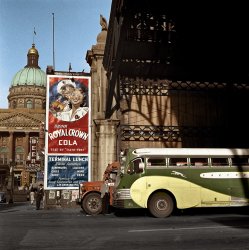
- Elmer and the Union Pacific
- ... family is genetically tied to transportation, especially railroads, so this shot of my Uncle getting back into the car is quite atypical ... Posted by notycoon22 - 05/21/2007 - 10:31pm -
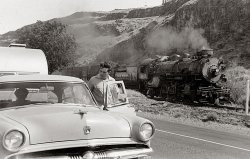
- Nash Flier: 1919
- ... to a full realization of the dangerous tactics of the railroads in stifling the greatest advance in transportation methods that ... Posted by Dave - 07/02/2015 - 12:23pm -
![Nash Flier: 1919 October 1919. "Nash Flier -- California Highway Motor Train in San Francisco." A publicity stunt showcasing the nascent field of long-distance trucking as facilitated by the "giant pneumatic tire." The cargo here being Sperry's Drifted Snow Flour. 6½ x 8½ glass negative from the Wyland Stanley collection. View full size.
Nash placeWe're at the Civic Auditorium at Polk and Grove Sts., kitty-corner from City Hall. Though not on the fair grounds, it was built for the 1915 Panama-Pacific International Exposition and afterward given to the city. It was renamed the Bill Graham Civic Auditorium in 1991.
"Ship by Truck Week"The California Highway Motor Train event took place during the first "Ship by Truck Week" which took place during the last week of September and first two weeks of September in 1919. Yes, it was more than one week long. The slogan originated with Harvey S. Firestone, president of the Firestone Tire and Rubber Company of Akron, Ohio. The governors of 32 states issued official proclamations in honor of the week in their states. There were also truck parades in over 100 cities. The largest of these parades was the one in Brooklyn, New York where 3,051 trucks participated. The slogan was adopted in 1920 by the National Association of Motor Truck Sales Managers.
Part of the reason for having such a week was that the railroad industry was giving the trucking industry a hard time about using the public roads - despite the fact that individuals and companies that owned trucks were already paying higher road taxes. A trade ad in the Oakland Tribune on October 12, 1919 (Section O, Page 13) stated the following.
"When America went to war the motor truck gave the element of speed so vitally needed. By the thousands these land transports saved time, money, and lives and figured conspicuously in destroying the enemy of humanity.
"When the rail systems of America were over-burdened and sought assistance in the expeditious movement of foodstuffs and freight, it was the motor truck that quickly and efficiently answered the call.
"Yet a most bitter fight, sponsored by powerful railway interests, is being waged against the existence and growth of transportation of freight and passengers by automobile and motor truck in California. They would deny this superior transportation service the use of the public highway. Railroad attorneys have made it a point to attend Railroad Commission and [San Francisco] Board of Supervisor hearings wherein franchise matters were being discussed to prevent an increase in this means of [truck] transportation.
"The public must be awakened to a full realization of the dangerous tactics of the railroads in stifling the greatest advance in transportation methods that recent generations have known."
The article below from page 88 of the January 1920 issue of the magazine "Power Wagon" gives further details of the California Highway Motor Train.
(The Gallery, Cars, Trucks, Buses, San Francisco, W. Stanley)](https://www.shorpy.com/files/images/SHORPY-355-01.thumbnail.jpg)
- Fallen Arch, Cheshire, CT - 1967
- ... the bridge was replaced with a modern banality. Numerous railroads have owned the old line over the years and all rail traffic on this ... Posted by ctyankeeinma - 08/01/2018 - 4:56pm -
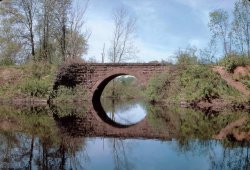
- Union Pacific 4709: 1920
- ... and grandfather were both civil engineers who worked for railroads and on other engineering projects such as large chimneys.
... Posted by Bruin - 06/10/2019 - 9:36am -
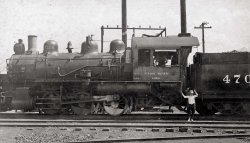
- Hart-Parr: 1910
- ... of the first farm tractor. The plant was serviced by two railroads, the Illinois Central and the Chicago, Milwaukee & St. Paul. ... Posted by jps56 - 05/18/2020 - 10:59am -
